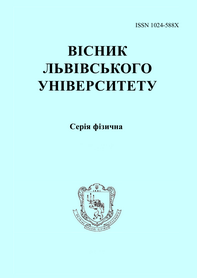Visnyk of the Lviv University. Series Physics
60 (2023) ñ. 116-126
DOI: https://doi.org/10.30970/vph.60.2023.116
Sensor elements based on the multi-walled carbon nanotubes – porous silicon nanosystem
I. Olenych, M. Pavlyk, R. Serkiz
|  |
(íå ìåíøå 1800 çíàê³â)
Carbon nanotubes (CNTs) have a high potential for creating gas sensors with low power consumption, operation at room temperatures and miniature sizes of sensitive elements. Therefore, the possibility of using a network of multi-walled CNTs on porous silicon (por-Si) substrate as low-cost sensors for toxic and explosive gases is studied in the work. An increase in the network of mwCNTs due to the nanotubes placed in the pores can lead to a higher sensitivity of gas sensors. It was established that mwCNTs form a disordered and heterogeneous network based on the analysis of SEM images of the sensor element surface. The porous morphology of the mwCNT–por-Si nanosystem provides an increase in the working surface and sensitivity of the gas sensor. The sensory properties of the obtained nanosystem were studied in AC mode by measuring electrical resistance and capacitance under the influence of adsorption of ammonia, acetone and ethanol molecules. An increase in the resistance and capacitance of the sensor elements due to the adsorption of molecules of analyzed gases was found. Based on the analysis of the dependences of the electrical characteristics and sensing ability of the mwCNT – por-Si nanosystem on the concentration of ammonia, acetone and ethanol molecules in the 0.4–12\% range, it was established that both resistive and capacitive type sensors have the greatest sensitivity to ammonia. In addition, the capacitive sensor element is characterized by a greater sensing ability than the resistive one. However, unambiguous identification of the analyte gas and determination of its concentration requires additional analysis of the response of the matrix of sensor elements with an individual profile of the transfer function. The response time of ammonia, acetone and ethanol sensors based on mwCNTs – por-Si nanosystem was about one minute at room temperature. The obtained sensor elements are characterized by quickly restoring functionality even without the use of special restoring procedures (e.g., heating). The mwCNTs–por-Si nanosystem shows the prospect of use in microelectronic sensor devices.
Full text (pdf)
References
- C. Koulamas, M.T. Lazarescu, Sensors 20, 5023 (2020). doi: 10.3390/s20185023.
- Z. Chen, C. Lu, Sensor Letters 3, 274 (2005). doi: 10.1166/sl.2005.045.
- T. Tharsika, M. Thanihaichelvan, A. S. M. A. Haseeb, S. A. Akbar, Frontiers in Materials 6, 122 (2019). doi: 10.3389/fmats.2019.00122.
- A. Cao, E. J. R. Sudholter, L. C. P. M. de Smet, Sensors 14, 245 (2014). doi: 10.3390/s140100245.
- C. J. Li, Y. Lu, Q. Ye, M. Cinke, J. Han, M. Meyyappan, Nano Lett. 3, 929 (2003). doi: 10.1021/nl034220x.
- E. Singh, M. Meyyappan, H. S. Nalwa, ACS Appl. Mater. Interfaces 9, 34544 (2017). doi: 10.1021/acsami.7b07063.
- Y. Wang, J. T. W. Yeow, Journal of Sensors 2009, 493904 (2009). doi: 10.1155/2009/493904.
- C. Cantalini, L. Valentini, I. Armentano, L. Lozzi, J.M. Kenny, S. Santucci, Sensors and Actuators B: Chemical 95, 195 (2003). doi: 10.1016/S0925-4005(03)00418-0.
- M. Mittal, A. Kumar, Sensors and Actuators B: Chemical 203, 349 (2014). doi: 10.1016/j.snb.2014.05.080.
- S. Y. Guo, P. X. Hou, H. X. Wang, C. Shi, H. T. Fang, C. Liu, Carbon 151, 156 (2019). doi: 10.1016/j.carbon.2019.05.045.
- S. J. Young, Z. D. Lin, Microsyst. Technol. 24, 55 (2018). doi: 10.1007/s00542-016-3154-2.
- J. Liu, J. Lu, X. Lin, Y. Tang, Y. Liu, T. Wang, H. Zhu, Computational Materials Science 129, 290 (2017). doi: 10.1016/j.commatsci.2016.12.035.
- H. G. Shiraz, F. R. Astaraei, S. Fardindoost, Z. S. Hosseini, RSC Adv. 6, 44410 (2016). doi: 10.1039/C6RA03541H.
- S. K. Abbas, A. N. Naje, J. Nano- Electron. Phys. 11(5), 05015 (2019). doi: 10.21272/jnep.11(5).05015.
- S. Ozdemir, J. Gole, Curr. Opin. in Solid State and Mater. Science 11, 92 (2007). doi: 10.1016/j.cossms.2008.06.003.
- C. Baratto, G. Faglia, G. Sberveglieri, Z. Gaburro, L. Pancheri, C. Oton, L. Pavesi, Sensors 2(3), 121 (2002). doi: 10.3390/s20300121.
- L. S. Monastyrskii, I. B. Olenych, O. I. Petryshyn, V. M. Lozynskyi, Sensor Electronics and Microsystems Technologies 15(2), 88 (2018) (in Ukrainian). doi: 10.18524/1815-7459.2018.2.136891.
- N. S. A. Eom, H. B. Cho, Y. Song, W. Lee, T. Sekino, Y. H. Choa, Sensors 17, 2750 (2017). doi: 10.3390/s17122750.
- I. B. Olenych, L. S. Monastyrskii, O. I. Aksimentyeva, L. Orovcik, M. Y. Salamakha, Mol. Cryst. Liq. Cryst. 673, 32 (2018). doi: 10.1080/15421406.2019.1578491.
- S. Peng, H. Ming, L. Mingda, M. Shuangyun, J. Semicond. 33, 054012 (2012). doi: 10.1088/1674-4926/33/5/054012.
- N. S. A. Eom, H. B. Cho, H. R. Lim, T. Y. Hwang, Y. Song, Y. H. Choa, RSC Adv. 8, 29995 (2018). doi: 10.1039/C8RA05520C.
- I. B. Olenych, J. Nano- Electron. Phys. 6, 04022 (2014).
- I. B. Olenych, O. I. Aksimentyeva, L. S. Monastyrskii, Y. Y. Horbenko, L. I. Yarytska, Nanoscale Research Letters 10, 187 (2015). doi: 10.1186/s11671-015-0896-1.
- O. Bisi, S. Ossicini, L. Pavesi, Surf. Sci. Rep. 38, 1 (2000). doi: 10.1016/S0167-5729(99)00012-6.
- Y. Vashpanov, H. Choo, D.S. Kim, Sensors 11, 10930 (2011). doi: 10.3390/s111110930.

